The Importance of Multi-Scale Temporal and Spatial Management for Cemetery Trees in Malmö, Sweden
Abstract
1. Introduction
2. Materials and Methods
2.1. Study Sites
2.2. Tree Inventory
2.3. Tree Management Plans
2.4. Canopy Cover Estimates
2.5. Manager Interviews
3. Results
3.1. Species Richness, Diversity, and Composition
3.2. Tree Damage and Risk Class
3.3. DBH Distribution, Decade Planted, and Vitality
3.4. Canopy Cover
3.5. Management Plans
3.6. Manager Interviews
4. Discussion
4.1. Species Diversity
4.2. Age and Size Class Diversity
4.3. The Importance of Multi-Scale Cemetery Tree Management in Malmö
4.3.1. Temporal Scales
4.3.2. Spatial Scales
5. Conclusions
Supplementary Materials
Author Contributions
Funding
Acknowledgments
Conflicts of Interest
References
- Konijnendijk, C.C.; Ricard, R.M.; Kenney, A.; Randrup, T.B. Defining urban forestry—A comparative perspective of North America and Europe. Urban For. Urban Green. 2006, 4, 93–103. [Google Scholar] [CrossRef]
- Armson, D.; Stringer, P.; Ennos, A.R. The effect of tree shade and grass on surface and globe temperatures in an urban area. Urban For. Urban Green. 2012, 11, 245–255. [Google Scholar] [CrossRef]
- Sanusi, R.; Johnstone, D.; May, P.; Livesley, S.J. Street orientation and side of the street greatly influence the microclimatic benefits street trees can provide in summer. J. Environ. Qual. 2016, 45, 167–174. [Google Scholar] [CrossRef] [PubMed]
- Berland, A.; Shiflett, S.A.; Shuster, W.D.; Garmestani, A.S.; Goddard, H.C.; Herrmann, D.L.; Hopton, M.E. The role of trees in urban stormwater management. Landsc. Urban Plan. 2017, 162, 167–177. [Google Scholar] [CrossRef] [PubMed]
- Tyrväinen, L.; Pauleit, S.; Seeland, K.; De Vries, S. Benefits and uses of urban forests and trees. In Urban Forests and Trees; Konijnendijk, C.C., Nilsson, K., Randrup, T.B., Schipperijn, J., Eds.; Springer: Berlin/Heidelberg, Germany, 2005; pp. 81–114. [Google Scholar]
- Tryjanowski, P.; Morelli, F.; Mikula, P.; Krištín, A.; Indykiewicz, P.; Grzywaczewski, G.; Kronenberg, J.; Jerzak, L. Bird diversity in urban green space: A large-scale analysis of differences between parks and cemeteries in Central Europe. Urban For. Urban Green. 2017, 27, 264–271. [Google Scholar] [CrossRef]
- Lindenmayer, D.B.; Laurance, W.F.; Franklin, J.F.; Likens, G.E.; Banks, S.C.; Blanchard, W.; Gibbons, P.; Ikin, K.; Blair, D.; McBurney, L.; et al. New policies for old trees: Averting a global crisis in a keystone ecological structure. Conserv. Lett. 2014, 7, 61–69. [Google Scholar] [CrossRef]
- Haaland, C.; Van Den Konijnendijk Bosch, C. Challenges and strategies for urban green-space planning in cities undergoing densification: A review. Urban For. Urban Green. 2015, 14, 760–771. [Google Scholar] [CrossRef]
- Poland, T.M.; McCullough, D.G. Emerald ash borer: Invasion of the urban forest and the threat to North America’s ash resource. J. For. 2006, 104, 118–124. [Google Scholar]
- Cale, J.A.; Garrison-Johnston, M.T.; Teale, S.A.; Castello, J.D. Beech bark disease in North America: Over a century of research revisited. For. Ecol. Manag. 2017, 394, 86–103. [Google Scholar] [CrossRef]
- Yang, J. Assessing the impact of climate change on urban tree species selection: A case study in Philadelphia. J. For. 2009, 107, 364–372. [Google Scholar]
- Ordóñez, C.; Duinker, P.N. Assessing the vulnerability of urban forests to climate change. Environ. Rev. 2014, 22, 311–321. [Google Scholar] [CrossRef]
- Borgström, S.T.; Elmqvist, T.; Angelstam, P.; Alfsen-Norodom, C. Scale mismatches in management of urban landscapes. Ecol. Soc. 2006, 11. [Google Scholar] [CrossRef]
- Richardson, E.; Shackleton, C.M. The extent and perceptions of vandalism as a cause of street tree damage in small towns in the Eastern Cape, South Africa. Urban For. Urban Green. 2014, 13, 425–432. [Google Scholar] [CrossRef]
- Limoges, S.; Pham, T.-T.-H.; Apparicio, P. Growing on the street: Multilevel correlates of street tree growth in Montreal. Urban For. Urban Green. 2018, 31, 15–25. [Google Scholar] [CrossRef]
- Vogt, J.M.; Watkins, S.L.; Mincey, S.K.; Patterson, M.S.; Fischer, B.C. Explaining planted-tree survival and growth in urban neighborhoods: A social–ecological approach to studying recently-planted trees in Indianapolis. Landsc. Urban Plan. 2015, 136, 130–143. [Google Scholar] [CrossRef]
- Millward, A.A.; Sabir, S. Benefits of a forested urban park: What is the value of Allan Gardens to the city of Toronto, Canada? Landsc. Urban Plan. 2011, 100, 177–188. [Google Scholar] [CrossRef]
- Nagendra, H.; Gopal, D. Tree diversity, distribution, history and change in urban parks: Studies in Bangalore, India. Urban Ecosyst. 2011, 14, 211–223. [Google Scholar] [CrossRef]
- Quinton, J.M.; Duinker, P.N. Beyond burial: Researching and managing cemeteries as urban green spaces, with examples from Canada. Environ. Rev. 2019, 27, 252–262. [Google Scholar] [CrossRef]
- Harvey, T. Sacred spaces, common places: The cemetery in the contemporary American city. Geogr. Rev. 2006, 96, 295–312. [Google Scholar] [CrossRef]
- Bovyn, R.A.; Lordon, M.C.; Grecco, A.E.; Leeper, A.C.; Lamontagne, J.M. Tree cavity availability in urban cemeteries and city parks. J. Urban Ecol. 2018, 5, 1–9. [Google Scholar] [CrossRef]
- Morelli, F.; Mikula, P.; Benedetti, Y.; Bussière, R.; Tryjanowski, P. Cemeteries support avian diversity likewise urban parks in European cities: Assessing taxonomic, evolutionary and functional diversity. Urban For. Urban Green. 2018, 36, 90–99. [Google Scholar] [CrossRef]
- Kowarik, I.; Buchholz, S.; von der Lippe, M.; Seitz, B. Biodiversity functions of urban cemeteries: Evidence from one of the largest Jewish cemeteries in Europe. Urban For. Urban Green. 2016, 19, 68–78. [Google Scholar] [CrossRef]
- Al-Akl, N.M.; Karaan, E.N.; Al-Zein, M.S.; Assaad, S. The landscape of urban cemeteries: Perceptions and preferences. Urban For. Urban Green. 2018, 33, 66–74. [Google Scholar] [CrossRef]
- Quinton, J.M.; Duinker, P.N.; Gallant, K.A.; Steenberg, J.W.N.; Charles, J.D.; Gallant, K.A.; Charles, J.D. To tree or not to tree: User and management perspectives of cemetery trees. Urban For. Urban Green. 2019, 43, 126385. [Google Scholar] [CrossRef]
- Lai, K.Y.; Scott, I.; Sun, Z. Everyday use of the city cemetery: A study of environmental qualities and perceived restorativeness in a Scottish context. Urban Sci. 2019, 3, 72. [Google Scholar] [CrossRef]
- Rugg, J. Defining the place of burial: What makes a cemetery a cemetery? Mortality 2000, 5, 259–275. [Google Scholar] [CrossRef]
- Woodthorpe, K. Sustaining the contemporary cemetery: Implementing policy alongside conflicting perspectives and purpose. Mortality 2011, 16, 259–276. [Google Scholar] [CrossRef]
- Burial Act [Begravningslagen]; Sweden, 1990. Available online: https://www.riksdagen.se/sv/dokument-lagar/dokument/svensk-forfattningssamling/begravningslag-19901144_sfs-1990-1144 (accessed on 8 July 2019).
- National Heritage Board Underhållsplan Och Åtgärdsplan. Available online: https://www.raa.se/kulturarv/forvaltning-av-kulturarv/4-underhallsplan-och-atgardsplan/ (accessed on 5 August 2019).
- Statistics Sweden Population Statistics: Quarter 1, 2019. Available online: https://www.scb.se/en/finding-statistics/statistics-by-subject-area/population/population-composition/population-statistics/pong/tables-and-graphs/quarterly-population-statistics--municipalities-counties-and-the-whole-country/quarter-1-2019/ (accessed on 25 July 2019).
- SMHI Ladda ner Meteorologiska Observationer. Available online: https://www.smhi.se/data/meteorologi/ladda-ner-meteorologiska-observationer/#param=precipitationMonthlySum,stations=all,stationid=52350 (accessed on 25 July 2019).
- Östberg, J.; Delshammar, T.; Nielsen, A.B. Standards for Conducting Tree Inventories in Urban Environments; Swedish University of Agricultural Sciences: Alnarp, Sweden, 2013. [Google Scholar]
- I-Tree i-Tree Eco Field Guide 7.2.2019 v6.0 2019. Available online: https://www.itreetools.org/documents/274/Ecov6_FieldManual_fn3zDWG.pdf (accessed on 25 July 2019).
- Parmehr, E.G.; Amati, M.; Taylor, E.J.; Livesley, S.J. Estimation of urban tree canopy cover using random point sampling and remote sensing methods. Urban For. Urban Green. 2016, 20, 160–171. [Google Scholar] [CrossRef]
- Braun, V.; Clarke, V. Using thematic analysis in psychology. Qual. Res. Psychol. 2006, 3, 77–101. [Google Scholar] [CrossRef]
- Malmö Stad Trädstrategi, Malmö, 2017. Available online: http://www.skkf.se/sites/default/files/editorial/tradstrategi_for_malmo_stad_170913_remiss.pdf (accessed on 28 July 2019).
- Mincey, S.K.; Schmitt-Harsh, M.; Thurau, R. Zoning, land use, and urban tree canopy cover: The importance of scale. Urban For. Urban Green. 2013, 12, 191–199. [Google Scholar] [CrossRef]
- Nowak, D.J.; Rowntree, R.A.; Mcpherson, E.G.; Sisinni, S.M.; Kerkmann, E.R.; Stevens, J.C. Measuring and analyzing urban tree cover. Landsc. Urban Plan. 1996, 36, 49–57. [Google Scholar] [CrossRef]
- Nowak, D.J.; Hirabayashi, S.; Doyle, M.; Mcgovern, M.; Pasher, J. Air pollution removal by urban forests in Canada and its effect on air quality and human health. Urban For. Urban Green. 2018, 29, 40–48. [Google Scholar] [CrossRef]
- Hauru, K.; Lehvävirta, S.; Korpela, K.; Kotze, D.J. Closure of view to the urban matrix has positive effects on perceived restorativeness in urban forests in Helsinki, Finland. Landsc. Urban Plan. 2012, 107, 361–369. [Google Scholar] [CrossRef]
- Tyrväinen, L.; Ojala, A.; Korpela, K.; Lanki, T.; Tsunetsugu, Y.; Kagawa, T. The influence of urban green environments on stress relief measures: A field experiment. J. Environ. Psychol. 2014, 38, 1–9. [Google Scholar] [CrossRef]
- Rydberg, D.; Falck, J. Urban forestry in Sweden from a silvicultural perspective: A review. Landsc. Urban Plan. 2000, 47, 1–18. [Google Scholar] [CrossRef]
- Skår, M.; Nordh, H.; Swensen, G. Green urban cemeteries: More than just parks. J. Urban. Int. Res. Placemak. Urban Sustain. 2018, 9175, 1–21. [Google Scholar] [CrossRef]
- Nordh, H.; Evensen, K.H.; Skår, M. A peaceful place in the city—A qualitative study of restorative components of the cemetery. Landsc. Urban Plan. 2017, 167, 108–117. [Google Scholar] [CrossRef]
- Konarska, J.; Uddling, J.; Holmer, B.; Lutz, M. Transpiration of urban trees and its cooling effect in a high latitude city. Int. J. Biometeorol. 2015. [Google Scholar] [CrossRef]
- Sjöman, H.; Östberg, J.; Bühler, O. Diversity and distribution of the urban tree population in ten major Nordic cities. Urban For. Urban Green. 2011, 11, 31–39. [Google Scholar] [CrossRef]
- Stål, Ö.; Östberg, J.; Nilsson, H.; Henriksson, K. Lunds Pastorat Trädvårds och Åtgärdsplan för: Allahelgona, Norra, Sankt Peters Kloster och Östra Kyrkogården; Lunds Pastorat: Lund, Sweden, 2015. [Google Scholar]
- Stål, Ö.; Östberg, J.; Nilsson, H.; Henriksson, K. Lunds Pastorat Trädvårds och Åtgärdsplan för: Fredentorp, Håstad, Igelösa, Odarslöv, Stora Råby, Stångby, Vallkärra och Västra Hoby Kyrkogård; Lunds Pastorat: Lund, Sweden, 2015. [Google Scholar]
- Sjöman, H.; Östberg, J. Vulnerability of ten major Nordic cities to potential tree losses caused by longhorned beetles. Urban Ecosyst. 2019, 22, 385–395. [Google Scholar] [CrossRef]
- Thomsen, P.; Bühler, O.; Kristoffersen, P. Diversity of street tree populations in larger Danish municipalities. Urban For. Urban Green. 2016, 15, 200–210. [Google Scholar] [CrossRef]
- Pretzsch, H.; Biber, P.; Uhl, E.; Dahlhausen, J.; Rötzer, T.; Caldentey, J.; Koike, T.; van Con, T.; Chavanne, A.; Seifert, T.; et al. Crown size and growing space requirement of common tree species in urban centres, parks, and forests. Urban For. Urban Green. 2015, 14, 466–479. [Google Scholar] [CrossRef]
- De Lacy, P.; Shackleton, C.M. Woody plant species richness, composition and structure in urban sacred sites, Grahamstown, South Africa. Urban Ecosyst. 2017, 20, 1–11. [Google Scholar] [CrossRef]
- Alvey, A.A. Promoting and preserving biodiversity in the urban forest. Urban For. Urban Green. 2006, 5, 195–201. [Google Scholar] [CrossRef]
- Lacán, I.; Mcbride, J.R. Pest Vulnerability Matrix (PVM): A graphic model for assessing the interaction between tree species diversity and urban forest susceptibility to insects and diseases. Urban For. Urban Green. 2008, 7, 291–300. [Google Scholar] [CrossRef]
- Roloff, A.; Korn, S.; Gillner, S. The Climate-Species-Matrix to select tree species for urban habitats considering climate change. Urban For. Urban Green. 2009, 8, 295–308. [Google Scholar] [CrossRef]
- Morgenroth, J.; Östberg, J.; Konijnendijk van den Bosch, C.; Nielsen, A.B.; Hauer, R.; Sjöman, H.; Chen, W.; Jansson, M. Urban tree diversity—Taking stock and looking ahead. Urban For. Urban Green. 2016, 15, 1–5. [Google Scholar] [CrossRef]
- Hedblom, M.; Söderström, B. Woodlands across Swedish urban gradients: Status, structure and management implications. Landsc. Urban Plan. 2008, 84, 62–73. [Google Scholar] [CrossRef]
- Barker, P.A. Ordinance control of street trees. J. Arboric. 1975, 1, 212–215. [Google Scholar]
- Miller, R.H.; Miller, R.W. Planting survival of selected street tree taxa. J. Arboric. 1991, 17, 185–191. [Google Scholar]
- Moll, G. Improving the health of the urban forest. In A Resource Guide for Urban and Community Forests; Moll, G., Ebenreck, S., Eds.; Island Press: Washington, DC, USA, 1989; pp. 119–130. [Google Scholar]
- Santamour, F.S. Trees for urban planting: Diversity, uniformity, and common sense. In Proceedings of the Seventh Conference of the Metropolitan Tree Improvement Alliance (METRIA), Lisle, IL, USA, 11–12 June 1990; pp. 57–65. [Google Scholar]
- Grey, G.W.; Deneke, F.J. Urban Forestry, 2nd ed.; Wiley: New York, NY, USA, 1986. [Google Scholar]
- Kendal, D.; Dobbs, C.; Lohr, V.I. Global patterns of diversity in the urban forest: Is there evidence to support the 10/20/30 rule? Urban For. Urban Green. 2014, 13, 411–417. [Google Scholar] [CrossRef]
- Nordh, H.; Evensen, K.H. Qualities and functions ascribed to urban cemeteries across the capital cities of Scandinavia. Urban For. Urban Green. 2018, 33, 80–91. [Google Scholar] [CrossRef]
- Valenta, V.; Moser, D.; Kapeller, S.; Essl, F. A new forest pest in Europe: A review of Emerald ash borer (Agrilus planipennis) invasion. J. Appl. Entomol. 2017, 141, 507–526. [Google Scholar] [CrossRef]
- Harwood, T.D.; Tomlinson, I.; Potter, C.A.; Knight, J.D. Dutch elm disease revisited: Past, present and future management in Great Britain. Plant Pathol. 2011, 60, 545–555. [Google Scholar] [CrossRef]
- Gough, P. Conifers and commemoration—The politics and protocol of planting. Landsc. Res. 1996, 21, 73–87. [Google Scholar] [CrossRef]
- Jones, O. Arnos Vale Cemetery and the lively materialities of trees in place. Gard. Hist. 2007, 35, 149–171. [Google Scholar]
- Zhang, Y.; Zheng, B. Urban trees programs from municipal officials’ perspective: Evidence from Alabama, U.S. Arboric. Urban For. 2012, 38, 160–167. [Google Scholar]
- McPherson, E.G.; Simpson, J.R. A comparison of municipal forest benefits and costs in Modesto and Santa Monica, California, USA. Urban For. Urban Green. 2002, 1, 61–74. [Google Scholar] [CrossRef]
- De Bello, F.; Lavorel, S.; Díaz, S.; Harrington, R.; Cornelissen, J.H.C.; Bardgett, R.D.; Berg, M.P.; Cipriotti, P.; Feld, C.K.; Hering, D.; et al. Towards an assessment of multiple ecosystem processes and services via functional traits. Biodivers. Conserv. 2010, 19, 2873–2893. [Google Scholar] [CrossRef]
- Christensen, N.L.; Bartuska, A.M.; Brown, J.H.; Carpenter, S.; Antonio, C.D.; Francis, R.; Franklin, J.F.; Macmahon, J.A.; Noss, R.F.; Parsons, D.J.; et al. The Report of the Ecological Society of America Committee on the Scientific Basis for Ecosystem Management. Ecol. Appl. 1996, 6, 665–691. [Google Scholar] [CrossRef]
- Steenberg, J.W.N.; Duinker, P.N.; Charles, J.D. The neighbourhood approach to urban forest management: The case of Halifax, Canada. Landsc. Urban Plan. 2013, 117, 135–144. [Google Scholar] [CrossRef]
- Ishii, H.T.; Tohru, M.; Ito, K.; Fujita, N.; Ayumi, I.; Hashimoto, D.; Iwasaki, A. Integrating ecological and cultural values toward conservation and utilization of shrine/temple forests as urban green space in Japanese cities. Landsc. Ecol. Eng. 2010, 6, 307–315. [Google Scholar] [CrossRef]
- Millward, A.A.; Sabir, S. Structure of a forested urban park: Implications for strategic management. J. Environ. Manag. 2010, 91, 2215–2224. [Google Scholar] [CrossRef] [PubMed]
- Davies, H.J.; Doick, K.J.; Hudson, M.D.; Schreckenberg, K. Challenges for tree officers to enhance the provision of regulating ecosystem services from urban forests. Environ. Res. 2017, 156, 97–107. [Google Scholar] [CrossRef] [PubMed]
- Pothier, A.J.; Millward, A.A. Valuing trees on city-centre institutional land: An opportunity for urban forest management. J. Environ. Plan. Manag. 2013, 56, 1380–1402. [Google Scholar] [CrossRef]
- Sloane, D.C. The Last Great Necessity: Cemeteries in American History; The John Hopkins University Press: Baltimore, MD, USA, 1991. [Google Scholar]
- De Groot, R.S.; Alkemade, R.; Braat, L.; Hein, L.; Willemen, L. Challenges in integrating the concept of ecosystem services and values in landscape planning, management and decision making. Ecol. Complex. 2010, 7, 260–272. [Google Scholar] [CrossRef]
- Kjøller, C.P. Managing green spaces of the deceased: Characteristics and dynamics of Danish cemetery administrations. Urban For. Urban Green. 2012, 11, 339–348. [Google Scholar] [CrossRef]
- Locke, D.H.; Landry, S.M.; Grove, J.M.; Chowdhury, R.R. What’s scale got to do with it? Models for urban tree canopy. J. Urban Ecol. 2016, 2. [Google Scholar] [CrossRef]
- Pham, T.-T.-H.; Apparicio, P.; Landry, S.; Lewnard, J. Disentangling the effects of urban form and socio-demographic context on street tree cover: A multi-level analysis from Montréal. Landsc. Urban Plan. 2017, 157, 422–433. [Google Scholar] [CrossRef]
- Escobedo, F.J.; Kroeger, T.; Wagner, J.E. Urban forests and pollution mitigation: Analyzing ecosystem services and disservices. Environ. Pollut. 2011, 159, 2078–2087. [Google Scholar] [CrossRef]
- Busse Nielsen, A.; van den Bosch, M.; Maruthaveeran, S.; Konijnendijk van den Bosch, C.; Nielsen, A.B.; van den Bosch, C.K.; van den Bosch, M.; Maruthaveeran, S. Species richness in urban parks and its drivers: A review of empirical evidence. Urban Ecosyst. 2014, 17, 305–327. [Google Scholar] [CrossRef]

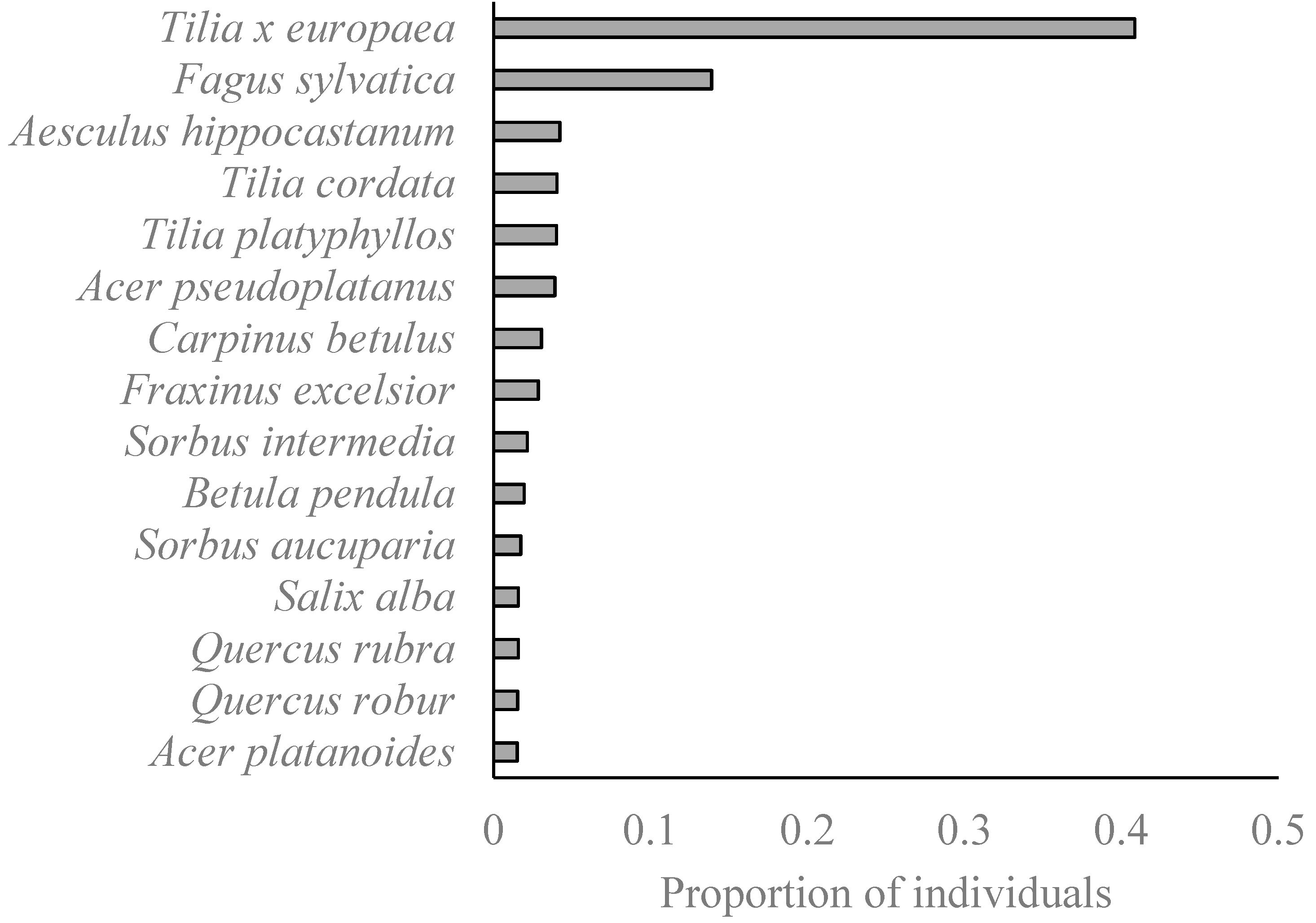
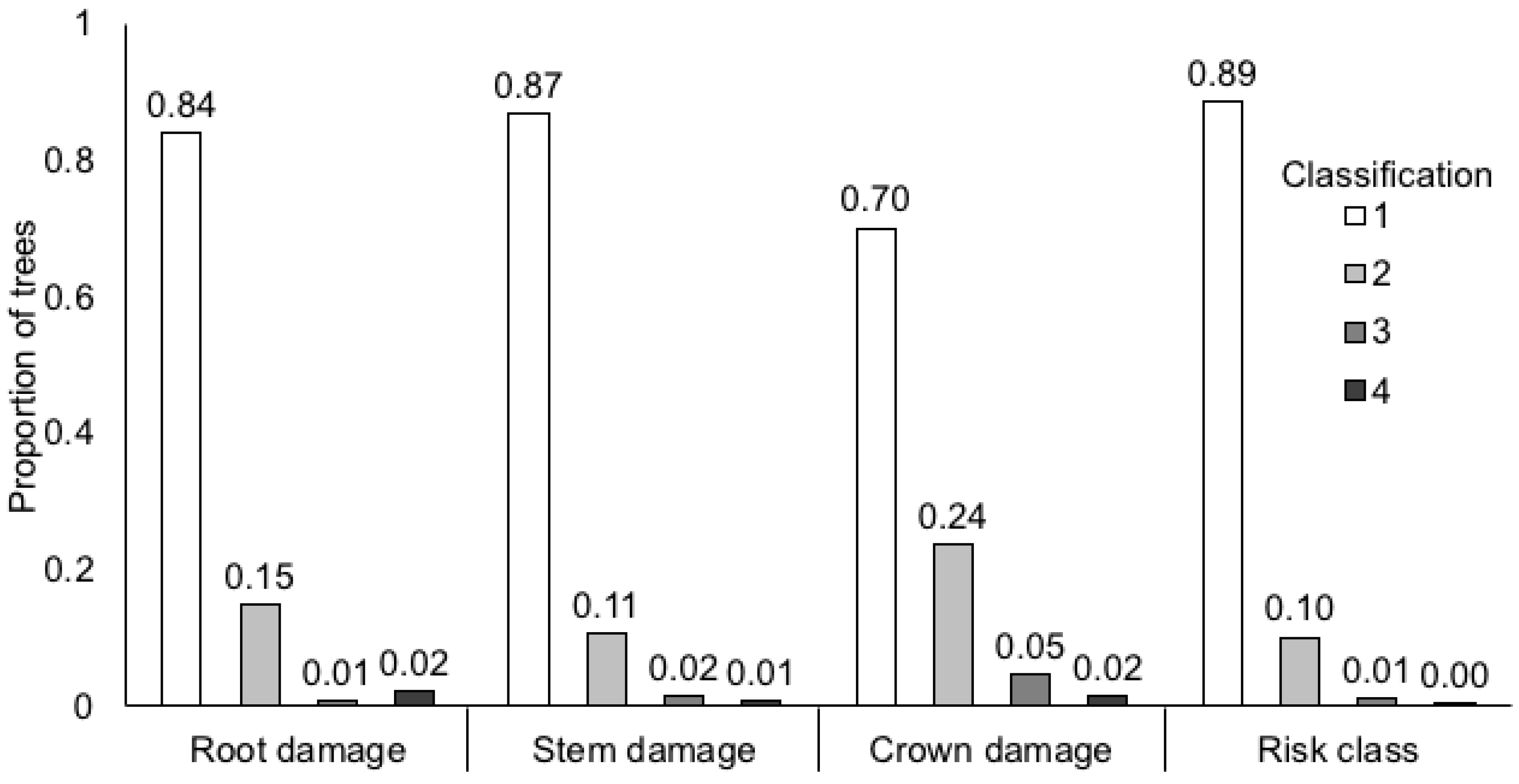
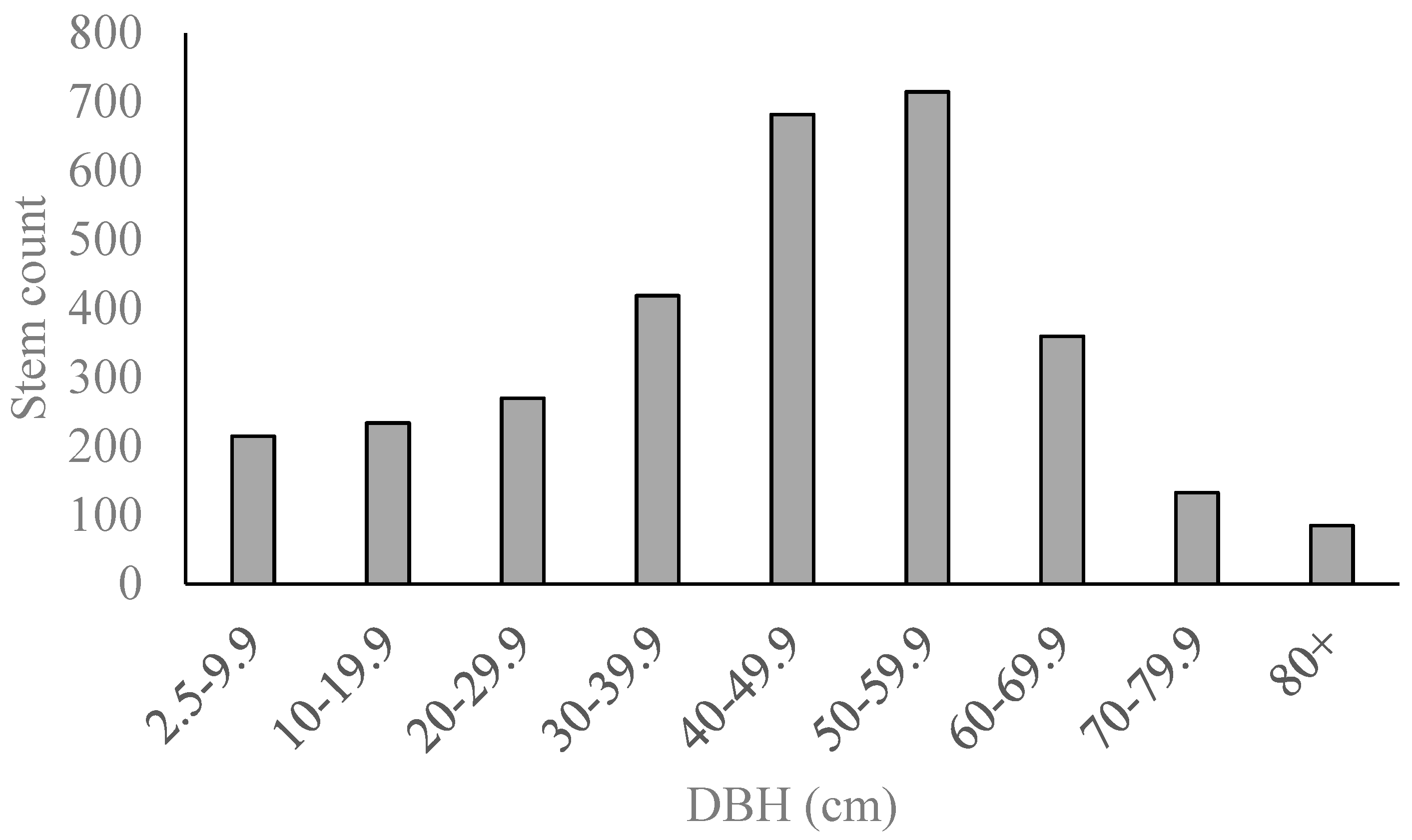
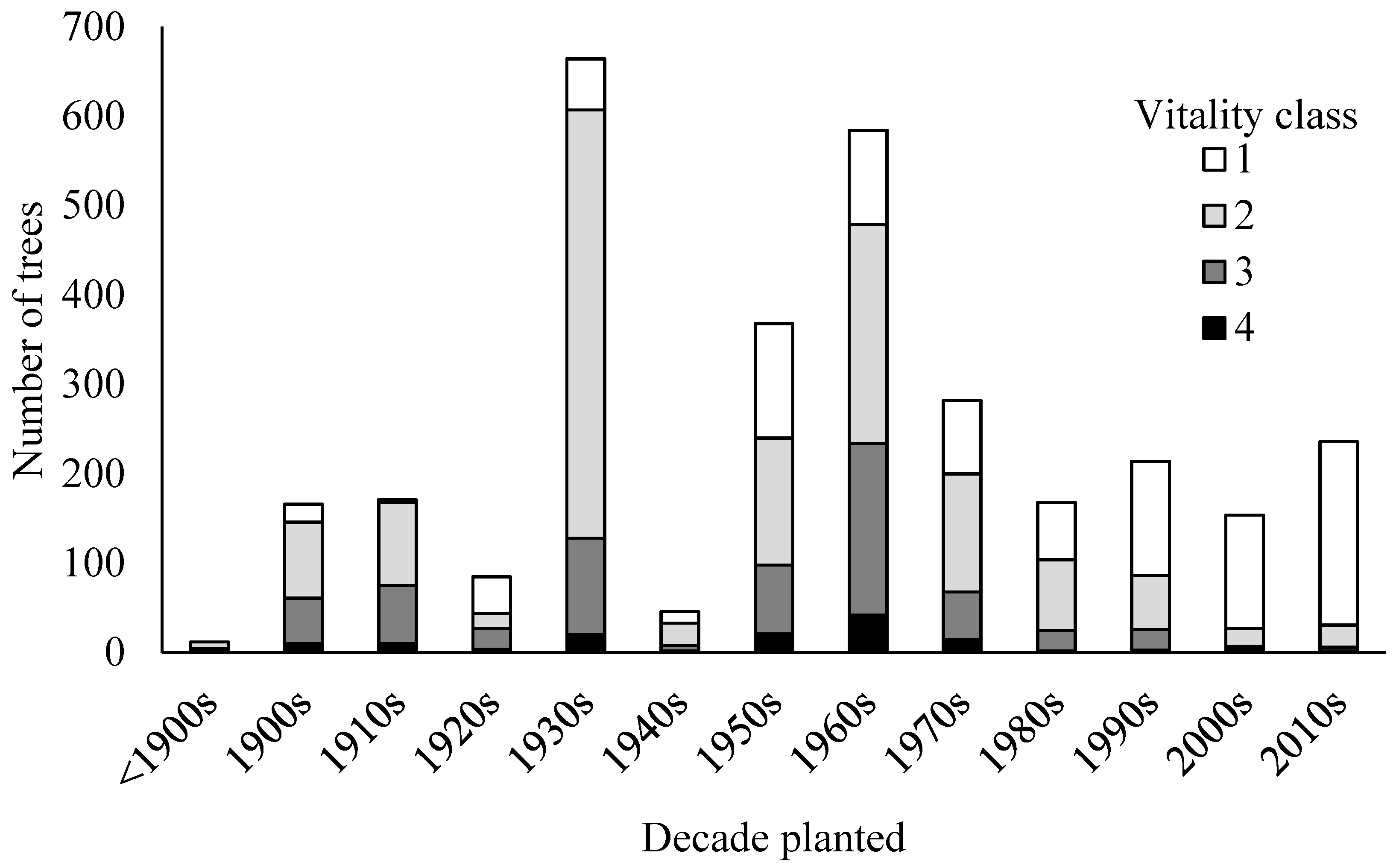
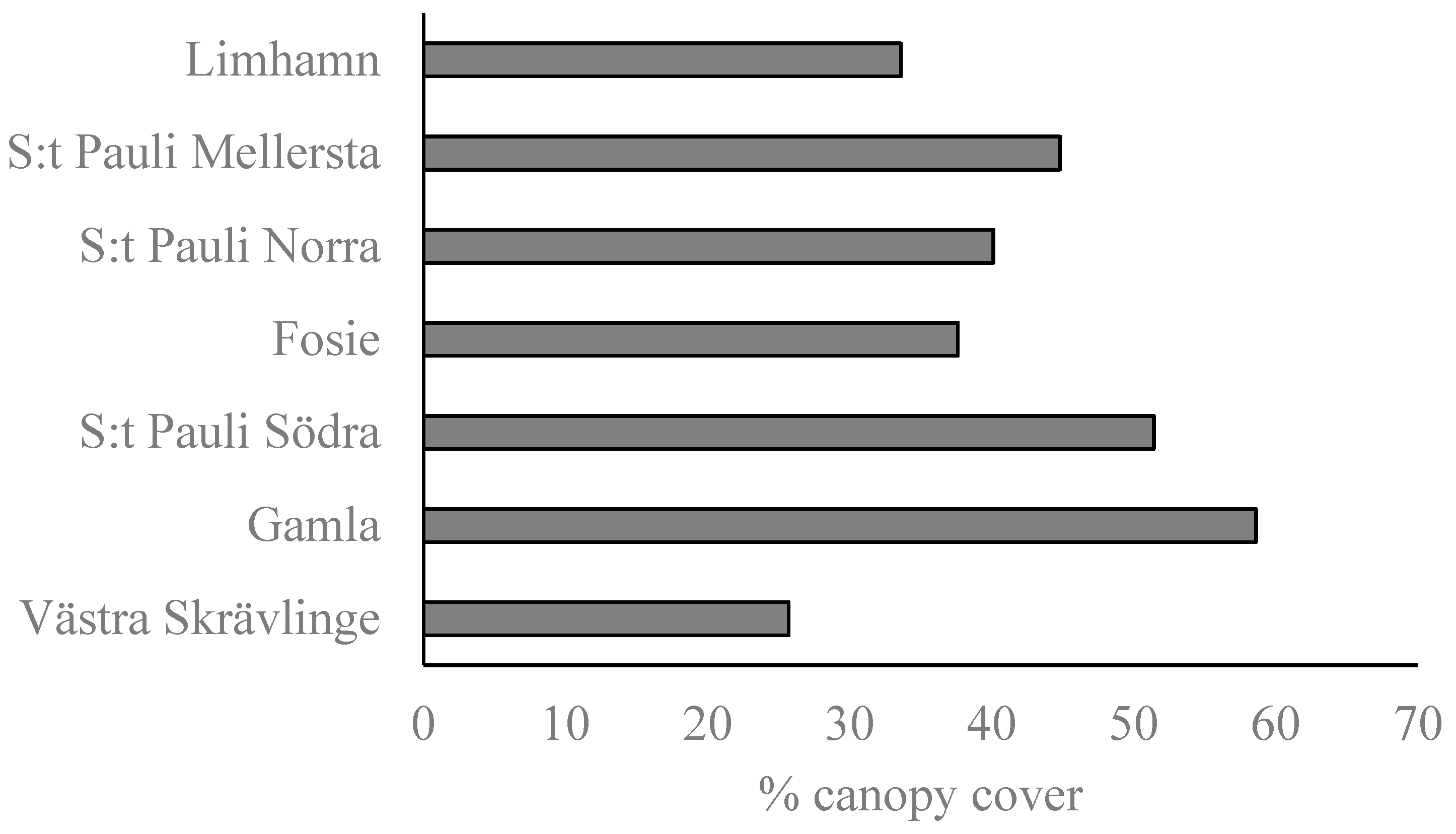
| Cemetery | Year Established | Area (ha) | Tree Density (Trees/ha) | Year of Management Plan Creation |
|---|---|---|---|---|
| Gamla | 1822 | 5.7 | 56.8 | 2015 |
| St Pauli Norra | 1870 | 8.0 | 52.4 | 2015 |
| St Pauli Mellersta | 1890 | 8.1 | 56.9 | 2015 |
| St Pauli Södra | 1904 | 6.0 | 53.8 | 2015 |
| Limhamn | 1880s | 22.9 | 47.1 | 2017 |
| Västra Skrävlinge | 1885 | 5.6 | 42.3 | 2018 |
| Fosie | 1896 | 6.1 | 49.9 | 2018 |
© 2020 by the authors. Licensee MDPI, Basel, Switzerland. This article is an open access article distributed under the terms and conditions of the Creative Commons Attribution (CC BY) license (http://creativecommons.org/licenses/by/4.0/).
Share and Cite
Quinton, J.M.; Östberg, J.; Duinker, P.N. The Importance of Multi-Scale Temporal and Spatial Management for Cemetery Trees in Malmö, Sweden. Forests 2020, 11, 78. https://doi.org/10.3390/f11010078
Quinton JM, Östberg J, Duinker PN. The Importance of Multi-Scale Temporal and Spatial Management for Cemetery Trees in Malmö, Sweden. Forests. 2020; 11(1):78. https://doi.org/10.3390/f11010078
Chicago/Turabian StyleQuinton, Jessica M., Johan Östberg, and Peter N. Duinker. 2020. "The Importance of Multi-Scale Temporal and Spatial Management for Cemetery Trees in Malmö, Sweden" Forests 11, no. 1: 78. https://doi.org/10.3390/f11010078
APA StyleQuinton, J. M., Östberg, J., & Duinker, P. N. (2020). The Importance of Multi-Scale Temporal and Spatial Management for Cemetery Trees in Malmö, Sweden. Forests, 11(1), 78. https://doi.org/10.3390/f11010078






